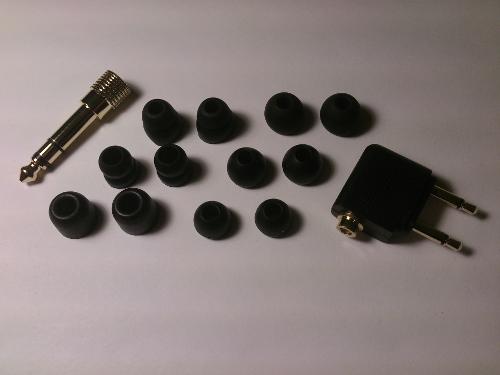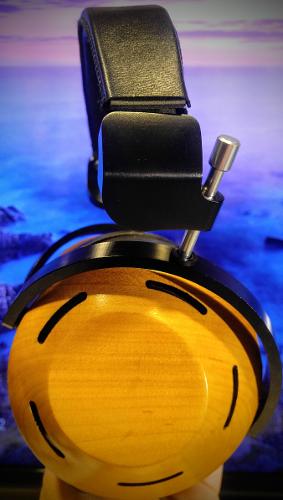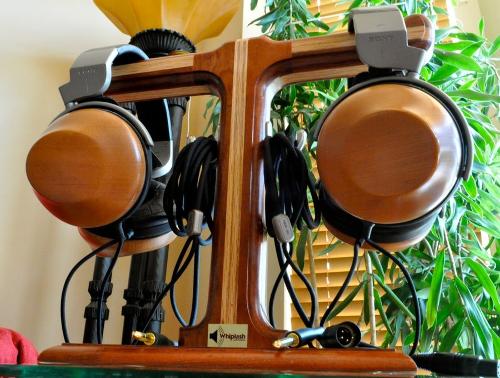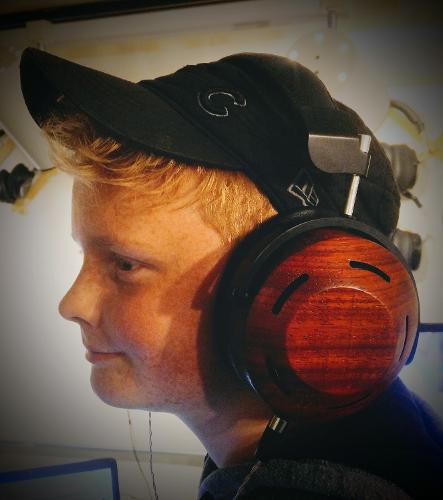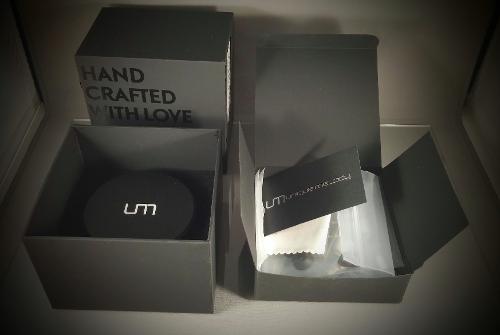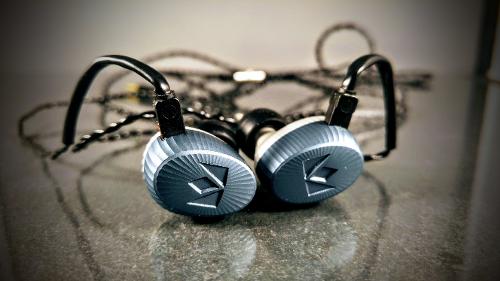
At the time this review was written, the Noble Kaiser Encore was listed for sale on Noble Audio’s website. Here is a link to their listing of the product:
https://nobleaudio.com/en/shop/universal/kaiser-encore/
Introduction
As I become more seasoned in this hobby my preferences continuously evolve. When I first started buying earphones, I was looking for in-ear monitors with a lot of bass and a slight V-signature. That preference has changed over time. I’m no longer looking for an earphone that will blow my brains out with thumping bass (respect to you if that’s your thing). I now look for an earphone that can do everything well at the same time. I want a perceptually even amount of detail, accuracy and tone at each frequency range. This is a feat that is seldom done, and often times difficult to accomplish.
I listen to different earphones quite often and I’ve only scratched the surface of everything that’s out there. Although there are tons of in-ears to choose from, picking between a bunch of possible options becomes another problem in itself. This especially applies to high end monitors. When you are looking to spend a more substantial amount of money on a product, the risk to reward factor is increased exponentially. Picking between several options becomes a daunting task. Simply put, we all want the biggest return on our investment. Taking a stab in the dark on a high end product can turn out to be a tremendous disappointment. This is why we read the reviews and ask questions. We want to know what the best options are before we make a purchase.
I’m not an “expert” at this stuff. I don’t claim to have a golden ear, nor do I consider myself the say all and know all of what a good earphone is. I’ve heard many of the world’s best earphones at each price point. I’ve been blown away by some stuff (regardless of price), while other products I’ve walked away shaking my head wondering what the heck all the fuss was all about. All I can do with a review is give my honest opinion, be fair to both the manufacturer and the reader who is taking time out of their day to read that opinion, and write a review that respects all listening preferences. If I can give you a good sense of what an earphone is like, I’ve done my job.
When Noble sent me a review sample of the Katana, not only was I honored to have the opportunity. I was really impressed by what Noble did in terms of venturing from their previous flagship tuning, the Noble K10. Although the original flagship (the Noble K10U) was a legend, the new Katana was an improvement over the K10U in terms of extension, soundstage, separation and detail. I pointed out the differences between the two in my review and explained why I would give a slight advantage to the nine driver Katana. Even still, there were things about the K10U that I enjoyed over the Katana. It had a richness and dynamic tone in the lower registers that made them seem less fatiguing and more musical.
Over the course of the review I emailed Noble a few times, asking questions and sharing my impressions. During these conversations Noble’s rep responded, telling me that there were “future projects” in the works. With that being said that my curiosity peaked instantly. When the Encore was announced, I got a shipping notification. The Encore was on its way, and I was about to see what the “secret project” was all about. Here is a statement from Noble about the Encore:
“The Encore retains the musical essence of the K10 and features a retooled midrange that provides additional clarity and more accurate tonal balance while still integrating seamlessly with the rest of the audio spectrum. Improvements in midrange response contribute to a larger soundstage and presentation compared to the K10 with more precise imaging and superior spatial representation.”
There is no such thing as a perfect earphone for everyone because the diversity of people’s preferences prevent that from being a possibility. However, there are some earphones that come close for me. Let’s do a comprehensive review to one of these products, the Noble Kaiser Encore.
Disclaimer
I was given a free loaner of the Encore in exchange for my honest opinion and review. I am in no way affiliated with Noble Audio, aside from having a few review opportunities. I would like to take this time to personally thank Brannan for the opportunity to experience and review the product.
My Background
I AM NOT a numbers and graphs audiophile or sound engineer. Personal audio enthusiast? Absolutely! Headphone junkie? Possibly…
There’s something about quality DAPs, DACs, Amplifiers and Earphones that intrigues me. I want to hear any earphone that looks promising, in hopes that I can share my impressions with enthusiasts and help them find the audio product they’re looking for. My Head-Fi profile has a list of audio products ranked from favorite to least favorite. For me, this hobby is more about getting great price to performance ratio from a product, and having a variety of different gear to mix and match. With personal audio gear, we tend to pay a lot of money for minor upgrades. One thing I’ve learned over the last few years is that just because a headphone has a higher price tag, it doesn’t mean that it has superior build and sound quality.
I’m always looking for great audio at a great price. I’m after headphones and IEMs that give me the “WOW” factor. I can appreciate different builds and sound signatures as long as they are solidly built, with ergonomics and sound that is pleasing to my ears. It’s my pleasure to share my experiences with audio products and make recommendations based on gear I have owned and used.
REVIEW

If you’ve ever purchased a Noble earphone in the past you will recognize this premium box. There’s magic inside, trust me. Opening the box, owners are greeted with some Noble stickers, a velvet drawstring pouch and a premium black Pelican 1010 case.

Opening the case reveals the earphones, cable, carabiner, two rubber binding rings for portable rigs, owner’s card, a cleaning tool and a very nice selection of tips . The entire package is premium. You get everything you need to use and protect your investment.
Specifications and Accessories
Specifications
*10 proprietary balanced armature drivers per side
*Updated Noble universal form factor and geometry featuring creative precision machined aluminum housings
*Sensitive enough for use with smartphones as well as portable amps and DAPs
*Hand-assembled and matched
*Detachable cable with industry standard 2-pin configuration (0.78 mm diameter)
Noble doesn’t give much information beyond driver count. I don’t know the earphone’s exact impedance, but I’m guessing it’s fairly low. The sensitivity of the Encore is on par with most other flagship in-ear monitors, and can be driven loudly at low volumes.
Accessories

1X Pair Encore earphones
1X Braided cable with two pin connectors
1X Pelican Carrying case with carabiner
1X Velvet drawstring pouch
1X Earphones cleaning tool
1X Warranty card
2X Portable rig binding straps
3X Pair red/gray wide bore tips (S,M,L)
3X Pair blue/black narrow bore tips (S,M,L)
2X Pair memory foam tips (S/M,M/L)
1X Metal tips organizer plate
Housings

Encore’s housing is a very similar shape to the K10U, but with different colors and patterning in the earphone’s shell.
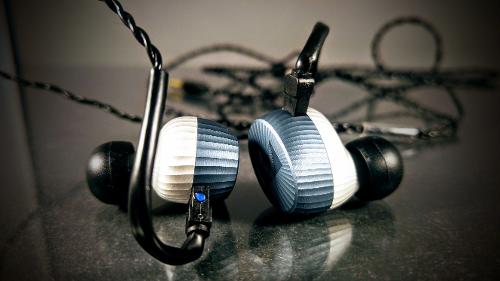
Encore has a earthy metallic satin teal anodized aluminum finish on the outer portion of the shell. The inner part of the shell is a satin aluminum finish. The pattern imprint on the shell is exquisite. I really like the way the lines of the earphone flows. As with all of the Noble universal lineup, the Noble emblem is stamped in the outside of the shell.
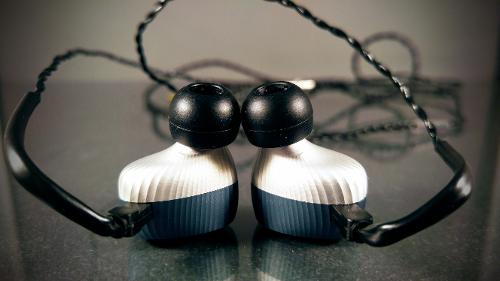
The overall shape is slightly bigger than the average universal monitor. They are pretty much the same size as the K10U, and slightly larger than the Katana.

The Encore nozzle is slightly wider than the average in-ear monitor. Although a little more effort is needed to do some tip rolling with aftermarket tips, I was able to get just about every tip I had (with the exception of Shure olives) to fit.
Cable, Y-Split, Cable Jack, Strain Reliefs
Encore’s stock cable is identical to the ones used in previous models. A four strand braided black rubber jacketed cable runs from the jack to the Y-split, then branches off into dual strand twisted braids that lead to each channel. The jack and Y-split are jacketed in metal, with a clear plastic tube just above the Ysplit. This operates as a chin/neck slider. The cable connects to each housing via a standard two-pin connection. About one and one half inches of memory wire run out from each two pin jack and helps users secure the earphones in place.
Functionality
There is no microphone or remote option in the stock package. The fact that the cable is removeable, an aftermarket microphone and remote can be purchased from several places. Here is a link to Noble’s versions of aftermarket cables, including a mic/remote option:
https://nobleaudio.com/en/shop/accessories/
Another clever little gadget I found on the Noble site is the Noble BTS. For all you Iphone 7 owners, I strongly suggest a device like this:
https://nobleaudio.com/en/shop/wireless/

NOTE: If wireless isn’t your thing and you’re an Iphone 7 owner, Noble is on the verge of releasing a lightning jack cable for their in-ear monitors. When this product is release I will update the review and add a link.
Ergonomics, Fit and Microphonics, Isolation

Despite being slightly larger than the average in-ear monitor, I got a great fit with the Encore. Just like all other Noble universals I’ve tried, the biggest key is finding the right tip (which plays a key role in both the fit and sound). I enjoyed the fit of and sound with the included black silicone tips best of all of the stock tip options. I did find aftermarket options that worked great as well. Once I found a set of tips that sealed well, it was as easy as popping them in my ears, securing them with the included memory wire, snugging them in place with the included chin/neck slider and enjoying them for extended periods of time with no need to adjust the fit.
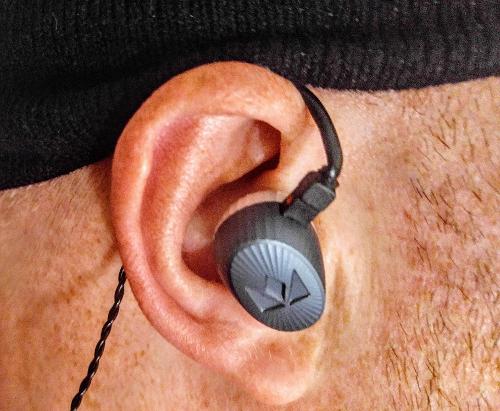
Isolation is better than average for a universal in-ear monitor. Although not on the same level as a custom shell, the Encore blocks a large majority of outside noise. With music playing at low volumes, average amounts of surrounding noise are not audible. This is one of the big reasons I really enjoy the Encore as much as I do. The tuning in combination with the level of isolation makes them an earphone I prefer to listen to at more modest volumes. Simply put, I don’t have to crank the volume up to tune the outside world out.
Sound Review
I did my demo with my usual gear. I used an LG-V10 for smartphone use, and either my Fiio X7 or iBasso DX80 DAP/Bushmaster D14 DAC/Amp for high fidelity portable use. For desktop use, I used my Toshiba Satellite Laptop in combination with a ifi micro iDSD playing at 32/192 kHz. I tested them with several other sources as well. I used Google Music in its highest download quality (320 KBPS), and also streamed FLAC via Tidal streaming service. I also used purchased and downloaded tracks in MP3, FLAC, WAV and DSD. I make sure that any gear I test has sufficient playtime before writing a review.
I used my usual same songs for testing gear:
“Limit to your love” by James Blake (bass speed, punch, response)
“Doin’ it Right” by Daft Punk (sub bass)
“Get lucky” by Daft Punk (bass to midrange transition resolution, male vocals)
“Madness” by Muse (soundstage, separation)
“Some nights” by Fun (soundstage and male vocals)
“The soundmaker” by Rodrigo y Gabriela (texture and imaging)
“Bassically” by Tei Shi (bass to midrange resolution, female vocals)
“Skinny Love” performed by Birdie (female vocals, acoustic playback)
“One” by Ed Sheeran (male vocals, acoustic playback)
“Outlands” from the Tron Legacy Soundtrack (symphonic presentation, imaging)
“Sultans of swing” by Dire Straits (detail, separation, balance)
“And Justic for All” by Metallica (driver distortion, treble response, rock playback)
“Ten thousand fists” by Disturbed (driver distortion, treble response, rock playback)
Note: Other tracks were used, but the listed songs were primarily used to assess and break down the gear’s response.
Source Selection
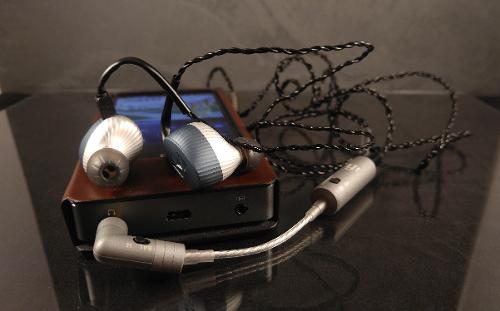
This ten driver design doesn’t come with exact impedance specification, but I’m guessing it’s on par with most earphones with multiple armature driver counts. They are pretty sensitive and can be driven easily with a smartphone. DAPs will work, but more powerful DAPs might reveal some background hiss when music isn’t playing, or you may pick up some occasional EMI and digital background noise. When music is playing this isn’t noticeable.
The Encore flat out rocked with my LG V10 and Iphone 6 Plus. I got great sound from the Cayin i5 and Fiio X7/AM3 combo, but there was a little background noise with both units. Using a powerful desktop unit is overkill, and if anything will yield more negative results than positive for the most part. When used with the iFi micro IDSD in its high sensitivity setting, the Encore sounded incredibly good.
These earphones will sound great with either colored or more linear sources. They are a phenomenally balanced and cohesive pair of earphones that will not discriminate any low powered source out there. Use the Encore with what it was intended for. A low power output portable source on low gain will be the sweet spot for them. Although you will get best results with higher quality recordings and higher bit-rate music files, the Encore won’t butcher your MP3s. I was able to enjoy the Encore with just about any music file I had. The Encore is incredibly true to your recordings.
Sound Signature
With this review I’m going to have to fight hard to not be cheesy or go over the top in terms of my appreciation for what these earphones can do. This is a result of me feeling that the Encore has hit a sweet spot in terms of its technical abilities and sound signature. At the time of writing this review, the Encore is one of the closest things I’ve heard to what I would consider perfect for my listening preferences.
To my ears, Noble has managed to take the best aspects of their previous flagships (the Katana and K10) and made a lovechild co-flagship. Take elements of the K10 cohesiveness and musicality, now add the soundstage of the Katana. On top of that, improve the transients and organic nature of its sound (primarily mid-range and upper frequencies). Next, make everything entirely cohesive, seamless and natural at all frequencies. Add all of this up and you have the Noble Encore. Yup, to my ears it adds up to an earphone that earns the title as one of Noble’s premier models.
The Encore is a microfraction leaner and brighter than their previous flagships. The trade-off is an earphone that creates an incredibly realistic sound experience to my ears. Although your mileage may vary, I don’t think there will be many people who hear these things and not consider them to be one of the most natural and cohesive earphones on the planet.
Bass
Bass has a similar tuning to other Noble monitors, packing a perceptually even amount of punch and rumble. With that being said, the Encore is a ever so slightly leaner than previous flagships. Although it may be just a touch above neutral, it’s close enough for me to say I don’t classify them as a bass forward earphone.
The Encore has a bass response that is NEVER intrusive to other frequencies. It has the ability to be soft and polite, but can also become robust and authoritative when called upon. During Daft Punk’s “Get Lucky” bass lines were incredibly fast in terms of attack and decay. The bass is tight, responsive, solid in tone and extends reasonably well. James Blake’s “Limit to Your Love” sounds incredible with Encore. The throbbing bass is authoritative without impacting James’ voice whatsoever.
Encore can bring it when tracks that call for a dynamic and impactful response is warranted. Encore has found that fine line needed to be universally world class. They will appeal to just about any listening preference. I’ve had people who prefer more warm and bassy sound listen to them, and just about all of them agree that for a more neutral tuning the Ecore bass is butt-kicking good. For those who preferred a colder and more linear tuning, most of them found them to be neutral enough to get the thumbs up, but emphasized enough to say they don’t follow the trend of being boring or analytical.
Mid-bass is incredibly responsive and has a maxed out sense of resolution. You get a slight sense of musicality, but with an incredibly fast and articulate delivery. Just like all other frequencies, the Encore takes detail and accuracy to an elite level while still managing to be entertaining.
Mid-range
This is where the Encore is a noticeable improvement over the previous flagships. Noble has taken a step forward from the K10 by adding air between the instruments and improving the separation in the lower to upper mid-range. To my ears the Encore puts on a mid-range clinic. Whatever Noble has done differently with the Encore mid-range, I consider it to be a huge step forward.
Lower mid-range seamlessly transitions from mid-bass tones, with a clean and accurate delivery. Compared to other earphones (like the K10 as well as other flagships), this frequency range is a bit thinner, but the trade off is an unrivaled clarity and airiness that is elite. Some may find the Encore to render some male vocals a bit thin, but I think that may be a product of whatever they are used to listening to. Once my ears acclimate to the Encore sound, it’s hard to go back to warmer and bassier earphones. Simply put, other earphones sound sloppy to my ears after jamming the Encore.
Upper mid-range is in nice balance with neighboring frequencies. Things to get a little emphasized at the far upper mid-range/lower treble range. Because of this some songs from rock and band genres can get a little edgy and aggressive at very loud volumes. Although that is the case, transients and detail are on another level. Listen to them at a moderate (and healthy) volume, this won’t be an issue.
Treble
Normally I would say that this will be an earphone that doesn’t appeal to those who are sensitive to treble frequencies, but I think everyone needs to give these a try before saying that. The transients and organic nature of the Encore’s upper frequency tuning is something everyone must experience. To be honest, it’s the closest thing I’ve heard to an HD800 in an in-ear monitor. It may be more forward than some in-ear monitors, but it’s sounds so incredibly real to my ears that it makes listening to most other in-ear monitors.
Cymbal crashes actually crash, with no perceived sense of roll off or unnatural decay. Pronunciation of the letters S and T are there with a reasonable amount of crispness, but again the overall sense is very natural at the same time. Do I think that treble could have been tuned down a few decibels? For some (those who are incredibly treble sensitive or those who listen at really loud volumes), maybe. For me the answer is a resounding NO. There’s so much good stuff going on that lowering it would take away from what I enjoy so much, which is an honest yet still slightly musical presentation.
Soundstage and Imaging
For me, the biggest deal about these things is the amount of air Noble has put between every instrument from top to bottom. The balance, separation and clarity is ahead of many other flagships, leaving me with an elite sense of soundstage and imaging. Listen to the Encore is the closest I’ve heard to and HD800-ish signature in an in-ear monitor. Imagine an HD800 sound with great isolation, ya, it’s that good to my ears. Of course your mileage may vary, but that’s what I’m hearing.
Comparisons
Noble Katana ($1850 USD on many sites)
The Katana is another recent Noble release. They are a nine driver co-flagship that sits somewhere between the older K10 and the Encore. Here is a link to my review:
http://www.head-fi.org/products/noble-audio-katana/reviews/17095
Comparing the two, the Katana seems to be a slightly warmer and more intimate sound, and closer in tuning to the original K10 than the Encore. The Encore has taken elements of the Katana and K10 and added an improved level of separation and clarity at midrange tones. With that being said, both earphones have their place as Noble co-flagships. For those who want the next step up from the original K10 without losing that same great bass response, Katana is the answer. For those who found the K10 to be a little bit too warm and colored and would like something that sounds more natural and clear with improved soundstage, the Encore is the answer.
Bouncing back and forth between the Encore and Katana, Katana has a little more bass and a little less treble (very minor). Katana’s midrange seems a hair more laid back and with a touch less airiness. The Encore has a slightly more linear approach. The overall sense is a slightly more detailed sound with improved clarity.
Build and accessories is virtually identical, with the most noticeable difference being that Katana’s housing is slightly smaller.
Unique Melody Miracle V2 ($1049 USD on Musicteck’s website)
The Miracle V2 has been a go to reference monitor for a good while. They have a very balanced tuning that is somewhat similar to the Encore. Here is a link to my review:
http://www.head-fi.org/products/unique-melody-miracle-v2-universal-six-driver-in-ear-monitor/reviews/15935
Comparing the two, both earphones have similar bass response. Mid-range seems slightly warmer and smoother on the Miracle V2. Treble is slightly smoother on the V2 as well. With all that being said, the Encore has a slightly better sense of clarity, separation and detail at almost every frequency. Although I do enjoy the Miracle V2 more with band and band and rock music, I prefer the Encore for every other genre. While the Miracle V2 is no slouch and warrants its asking price, Noble also justifies its more expensive price tag by adding a level of airiness and detail that the Miracle V2 can’t achieve. Both are going to make some great reference monitors.
Build quality and accessories goes to the Noble Encore. Their all metal housing and Pelican case are a slightly better offering than the Miracle V2 acrylic housing and metal cannister.
Conclusion
The Encore is incredible. If I could only give one in-ear monitor a five star review and had to lower every other five star rating to four and a half, the Encore would get the five star exception. At the time of writing this piece, the Encore is the most cohesive, detailed, clear and enjoyable earphone I’ve experienced. I’ve put the Encore up against the other flagships I currently have in my possession, and while others may give them a run for their money in many aspects, the overall experience I get when listening to the Encore makes it the current king of the hill.
The Encore might not be perfect for everyone. They won’t cater to the polar opposites of the listening spectrums (neutral/linear/bright or warm/colored/basshead sound signature preferences). For everyone in between, I’m confident they will be able to appreciate what Noble has done with these. The Encore is one of those earphones that sounds so “real” that many will throw personal preference to the side to say that these are entirely awesome. Upon the conclusion of this review, the Encore gets top honors in my list of favorite in-ear monitors.

Thanks for reading and happy listening!





































































